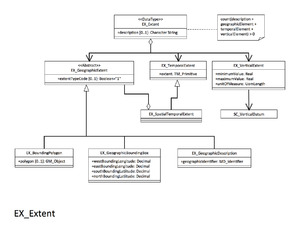Difference between revisions of "EX Extent"
From Earth Science Information Partners (ESIP)
| Line 70: | Line 70: | ||
</table> | </table> | ||
</div> | </div> | ||
| − | + | <br> | |
{{template:isoOrderingFooter}} | {{template:isoOrderingFooter}} | ||
*[[ISO Extents]] | *[[ISO Extents]] | ||
Revision as of 07:30, August 15, 2017
gex:EX_Extent
| Elements | Domain | Definition and Recommended Practice | Examples | ||
|---|---|---|---|---|---|
| 1 | gex:description | 0..1 | gco:CharacterString | Mandatory when gex:geographicElement, gex:temporalElement, and gex:verticalElement are not present. When there are multiple extents, this field is useful for identifying each extent. |
extent: (EX_Extent)
|
| 2 | gex:geographicElement (choose one) | 0..* | gex:EX_BoundingPolygon gex:EX_GeographicBoundingBox gex:EX_GeographicDescription |
Mandatory when gex:description, gex:temporalElement, and gex:verticalElement are not present. Geographic extent of the resource. At a minimum, provide the GeographicBoundingBox, because most discovery systems rely on this section for spatial searches. Not required when resource is non-geospatial and the scopeCode = 'nonGeographicDataset'. |
|
| 3 | gex:temporalElement (choose one) | 0..* | gex:EX_TemporalExtent gex:EX_SpatialTemporalExtent |
Mandatory when gex:description, gex:geographicElement, and gex:verticalElement are not present. Temporal extent of the resource. Describe the time period covered by the content of the resource or the date and time range when the data was collected. The use of multiple temporal extents should be explained in the attribute description of the extent. If the resource has a status of 'ongoing' then use the indeterminatePosition attribute without an end date value. Example: <gml:endPosition indeterminatePosition="now"/> |
|
| 4 | gex:verticalElement | 0..* | gex:EX_VerticalExtent | Mandatory when gex:description, gex:geographicElement, and gex:temporalElement are not present. Minimum and maximum vertical extent of the resource. |
|


